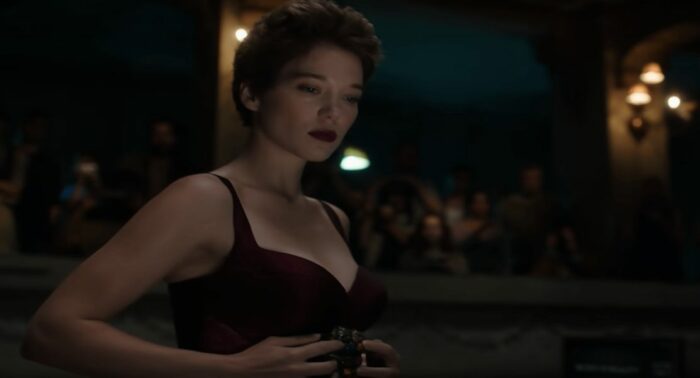Before now, I have only seen one David Cronenberg title, that being Videodrome. I quite like Videodrome; it is deserving of its insurmountable praise, and offers unique and poignant imagery that is seldom replicated elsewhere. As such, since its trailer I was very intrigued by the description of Cronenberg’s redo of his own 1970 film, Crimes of the Future. I love body horror; I love his approach to it, how he uses it to say something about humans and our relationships with each other’s and our own skin and bones. Judging by the synopsis, it looked like Crimes of the Future circa 2022 was shaping up to be another one of these exploits. Even only having one other Cronenberg title to contrast with, it seemed almost obvious where this new picture was going to head. And, now having seen Crimes of the Future, I think I was on the money, but it stretches far beyond just one idea. It’s to the point where it’s hard to track, but I’m going to give it a shot.
*Spoilers for the entire film.

The world in Crimes of the Future is facing fundamental change on a vast scale. Human bodies are evolving, many even deteriorating. Some need machines to eat, and some don’t eat food at all. There are forces fighting to maintain humanity, to push against this change, and others are fighting to embrace it. It’s progress vs stillness vs regression; the old normal vs the new normal.
The first character we’re introduced to is Brecken (Sozos Sotiris), a little boy who lives with his mother and is really into eating plastic. After his mother catches him devouring their bathroom trash can, she smothers him in his sleep. Here we see the two forces of the film: something new, and the hatred of that something. Aside from his diet, Brecken was just fine, but his mother detested the way his body worked so much that she had to kill him.
Our next set of characters are Saul and Caprice, a man with a tendency to grow mysterious new organs and the woman who cuts them out before an audience. Saul (Viggo Mortensen) is sickly, dealing with substantial pain and discomfort from the way his body is evolving. Therefore, he has Caprice (Léa Seydoux) remove the growths within him before he can find out what they do or don’t do, but also as a bit of an art project. Each time he grows a new organ, they enact a bit of performance art by opening him up and taking out the organ in front of a crowd of onlookers and fans. Their display is blatantly erotic, Saul clearly enjoying the sensation of being spread apart, and Catrice holding the biological-looking “remote” to their futuristic, equally-biological-looking surgery “machine” flush against her abdomen and fondling the colorful buttons.
In their first performance scene, “BODY IS REALITY” is depicted on a retro television screen—Saul’s body is reality; his evolution is reality. The audience seems to embrace this, finding great comfort and meaning in the performances. Yet Saul wishes to reject his body by repeatedly rejecting its procedure, though he is clearly not as hateful as Brecken’s mother. He’s arrived at a sort of peace with his situation, finding artistic meaning in it and believing it to be necessary for his survival. He doesn’t like what’s happening to him, but he’s also not one to complain.
“Just another epiphany. Art triumphs once again.”
Saul and Caprice become involved early on with a pair of individuals known to produce a sort of catalogue of new organs, Wippet (Don McKellar) and his timid associate Timlin (Kristen Stewart, bless her heart). I feel that these characters represent a fetishistic viewpoint; they are “stans” of Saul, so to speak. At one point this odd duo are interviewed by a detective, Cope (Welket Bungué), and they proclaim their adoration of Saul and Caprice’s performances. They say Saul’s new organs are like his own original artwork, but it is them saying that, not Saul; they like what his body is doing while he does not. Timlin even goes a step further, being sexually attracted to Saul and expressing desire to be carved by him. Surgery is indeed, as she proclaims, “the new sex.”
In fact, most of the characters in Crimes of the Future fetishize this performance art, desiring to carve designs into themselves and bare witness to the new human race’s many anomalies—even Caprice. At one point, she is so taken by the performance of a woman who is aroused by being cut and stabbed that she joins her to have small body mods implanted into her own forehead. This appears to disturb Saul; one of his most trusted friends is delving deeper into the communities that see him as a sort of artful messiah rather than a person in misery, and she wants to be like them. That must sting a little—unless I am misreading this piece of the story, which is completely possible.
“I’m afraid of everything.”
Yet another piece of this film is the boundary pushing of this world’s form of performance art. Brecken’s father, Lang (Scott Speedman), has received the corpse of his child as a cruel parting gift from the boy’s mother, and he wants Saul and Caprice to perform a live autopsy. Lang is the same as his son: a plastic-eater, but not a natural one. He had those organs implanted in order to become that way. He hopes showing Brecken’s body to a crowd can help advance his agenda of embracing the way the human body is evolving, as he believes his son was born with those organs even though he himself was not. Of course, Saul and Caprice are hesitant to cut open a dead child as part of a political display of sorts. If they did, would it be art, or atrocity? But in the end, they decide to do it anyway, and here’s where the film makes me feel a bit dizzy.
Whenever Saul grew a new organ, he was opened up prior to performance in order to get a tattoo on the new growth. If Brecken was simply born with all of these organs, they would theoretically be un-inked—but they are. When Saul performs the operation from a seated position above the “stage”, Brecken’s organs are revealed to be tattooed. I believe the implication then becomes that he was given these organs, didn’t grow them himself as was previously believed. Lang is, of course, crushed by this, and is shortly thereafter killed by some members of a governmental power who don’t want his kind around. Saul had actually been helping this government, having regular meetings with Detective Cope. In a sense, he was working on one end to push an anti-evolutionist rhetoric, while also pushing pro-evolutionism with his performances. He was caught in limbo, but after the murder of Lang and the tragedy of Brecken, he decides to abandon the side of the government.
In the end, it’s self-rejection vs self-acceptance, and it’s ambiguous which prevails. The plastic-eaters invented things called “Synth Bars”, purple plastic rectangles encased in candy wrappers. Those with the new digestive systems could eat them with no problem; no special chairs, no struggle, no choking. Lang attempted to get Saul to try one to no avail. He was unsure if it would kill him or if he’d be able to eat it just fine, perhaps afraid of both answers. In the last moments, tired of his struggle, he caves, and has Caprice fetch a Synth Bar for him. He takes a bite, chews, and is caught between a smile and a grimace. The film ends before he swallows, but I think he likes it. I think he sees change is inevitable, and it’s time to stop running.

As fascinating as Crimes of the Future is and as much as I love its ideas and many of its executions, something about it can’t keep ahold of me. Maybe it’s the plethora of points and ruminations on the world around us being too much for me to process at once. Maybe it’s the dingy color scheme. Maybe it’s me; maybe I’m dingy and too complicated. But I think what matters most is that others utterly adore it, and I enjoy watching people gush over it. I am glad it exists. I’ve yet to come across a creative quite like Cronenberg, and I’m happy he’s still out and about going at our brains with a pickaxe. No matter what, it’s always delightful to see movies so bizarre get wide releases, so I would recommend seeing this in cinemas if you can. It might be confusing to some, but it certainly isn’t boring, nor is it empty. It doesn’t quite have something for everyone, but it had something for me, and maybe it has everything you want.


